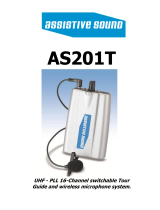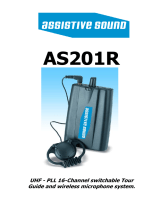
TG 500 – Safety information
3
Thank you for putting your trust in us and choosing to buy the
beyerdynamic TG 500 wireless system. Before using it for the first
time, please take a moment to carefully read this user manual.
The system is extremely flexible and is suitable for professional
audio applications on a stage, on tour or for installations.
It has an operating range of up to 120m with the supplied anten-
nas, and its large dynamic range allows for an excellent signal-to-
noise ratio.
The system is supplemented by ergonomic handheld and beltpack
transmitters. Sophisticated battery compartment solutions allow
for rapid battery replacement.
1. Safety information
General
• Please READ this user manual.
• Please KEEP this user manual.
• Please FOLLOW the specified operating and safety instructions.
Disclaimer
• Beyerdynamic GmbH & Co. KG will not be liable for any damage
to the product or injury to persons caused by negligent,
improper, incorrect or inappropriate operation of the product.
1.1 TG 500 receiver system
1. Please read these instructions.
2. Please keep these instructions.
3. Please observe all warnings.
4. Follow all instructions.
5. Do not use this device near water.
6. Only clean the device with a dry cloth.
7. Do not mount the device near sources of heat such as
radiators, heat accumulators, ovens or other appliances
(including power amplifiers) that give off heat.
8. Do not make any changes to this device’s power plug.
9. Protect the connector cable from pinching or kinking,
especially at the appliance itself and at the power plug.
10. Only use accessories for this device that are specified by the
manufacturer.
11. Disconnect the device from the mains during thunderstorms or
if you do not intend to use it for long periods of time.
12. All maintenance work must be carried out by service personnel
that are qualified to do so. Maintenance is required if the
device itself or its power cable has been damaged, if liquids
or objects have fallen into the device, if the device has been
exposed to rain or heavy moisture, if the device is not
operating properly, or if it has been dropped
Location
• The device must be set up in such a way that the power adaptor
and all connections on the rear of the device are easily
accessible.
• When transporting the device to a different location, make sure
it is adequately secured and that nobody can be injured in the
event of falls or impacts.
Fire safety
• Never place open fire sources (e.g. candles) on the device.
Moisture / heat sources
• Never expose the device to rain or high humidity. Do not install
it in the immediate vicinity of swimming pools, shower facilities,
damp basements or other areas with unusually high air
humidity.
• Never place objects filled with water (e.g. vases or drinking
glasses) on the device. Liquids in the devices may cause a short
circuit.
• Never install or operate the device in the immediate vicinity of
radiators, lighting systems or other heat-generating devices.
TG 500SR connection
• Lay all connector cables so that people cannot trip over them
and injure themselves.
• Always remove the power adaptor from the power supply when
undertaking any work on the inputs and outputs.
• The input voltage is 100–240V AC; the power consumption of
the device is approx. 3W.
• If the device has caused a defective fuse or a short circuit,
disconnect it from the mains and have it checked and repaired.
• Always unplug the power adaptor from the mains and/or the
device by pulling at the plug – never by pulling the cable.
• Do not use the device if the power adaptor is damaged.
• Connection of defective or unsuitable accessories could cause
damage to the device. Therefore, only use power adaptors that
are available from or recommended by beyerdynamic.
• To disconnect the device from the mains, pull the power adaptor
out of the power socket.
TG 500DR connection
• The device must be connected to a power socket with a
protective contact.
• Always lay the cable so that it cannot kink or be cut through by
sharp objects.
• Lay all connector cables so that people cannot trip over them
and injure themselves.
• Always turn off the power supply when undertaking any work on
the inputs and outputs.
• The input voltage is 100–240V AC; the power consumption of
the device is approx. 11W.
• Check whether the connection ratings correspond to the existing
mains supply. Connecting the system to an incorrect power
supply may cause serious damage. Incorrect voltage may
damage the device or cause an electric shock.
• Please note that different mains voltages require corresponding
power cables and connector plugs.
Please refer to the table below:
• If the device has caused a defective fuse or a short circuit,
disconnect it from the mains and have it checked and repaired.
• Do not touch the power cable with wet hands. There must be no
water or dust on the contact pins. In either case, you could
suffer an electric shock.
• The power cable must be securely connected. There is a risk of
fire if it is loose.
• Always unplug the power cable from the mains and/or the device
by pulling at the plug – never by pulling the cable. This could
damage the cable and cause an electric shock or fire.
• Do not use the device if the mains plug is damaged.
The lightning symbol in an isosceles triangle
alerts the user to an uninsulated and potentially
hazardous contact voltage within the device that may
be strong enough to give users an electric shock.
An exclamation mark in an isosceles triangle alerts
the user to important instructions for operating and
maintaining the product in the accompanying
documentation.
Voltage Standard power plug
110 to 125V UL817 and CSA C 22.2 No. 42.
220 to 230V CEE 7 page VII, SR section 107-2-D1/IEC 83 page C4.
240 V BS 1363 (1984): “Specification for 13A fused plugs
and switched and un-switched socket outlets.”
























